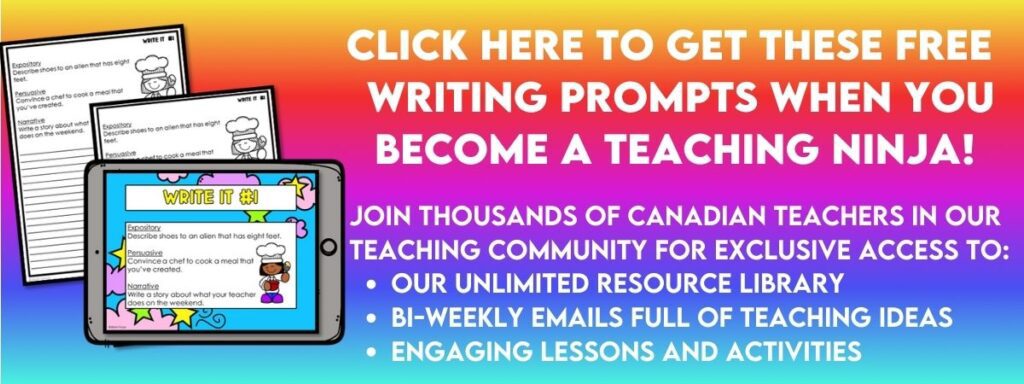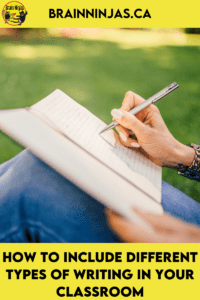
Over the years we’ve attended hundreds of hours of professional development for teaching students to write. Our school has tried out resources from Ruth Guthrie and the 6+ Traits of Writing, Barbara Mariconda and Empowering Writers and even Lucy Calkins and her Writers’ Workshop model. None of these were perfect. Some students did well with some of the lessons and some students didn’t see a lot of growth in their writing. Some students learned to follow a formula but struggled with being creative. How do you include different types of writing in your daily writing?
Not Another Writing Program
Instead of trying another “program,” we started looking at what we could do to help students that were still struggling with writing and found that all the different programs were missing one important piece…authenticity.
Students needed to feel like they were writing for a reason other than for an assignment. When we shifted that, we found students made huge strides in how they learned the different genres of writing. We started including writing tasks throughout our days, but the main idea was to do small amounts of writing throughout the day, rather than sitting and writing out a story over and over.
Four Types of Writing
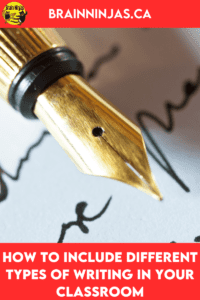
In our classroom, we tend to stick to four types of writing and make sure our students understand these serve different purposes for different audiences. The types of writing can come in a variety of formats: lists, letters, step-by-step directions, conversations and prose.
Expository
Writing that explains, gives directions, or describes. This blog post is an example of expository writing. It can include writing with a main idea, paragraph writing and supporting details.
Narrative
This is any type of story writing. While most people won’t grow up to write stories for a living, the skill of retelling events is important. Narrative writing also helps with retelling stories and reading comprehension in general.
Persuasive
Considering how many kids are good at arguing for the things they want, more students should be good at this format. Persuasive writing involves convincing others and using supporting facts to argue your point or position.
Poetry
This includes all types of poetry. Many students love to write short rhyming or free verse poems mostly because they are short and easy to do. It’s possible to study poetry every school day of the year and still not learn everything.
Write Every Day
We have our students write every day. Some days that is a paper and a pencil while others involve using a device to type or record our writing. The key component of this daily writing is consistency. Students know what to expect when we write: a quiet room, a limited amount of time, and the choice of topic.
Each day we present three writing prompts. We discuss them very briefly as a class and then students choose. They can also choose to continue writing something they are already working on or write something completely different. What they are writing does not matter as much as the actual writing.
We project a prompt up onto our classroom screen and students write on paper or on their device. They keep the writing in a binder (or a digital space) until we ask to see it or use it in a lesson. A few times a month we ask students to submit a writing sample that shows a specific skill or quality. They make the choice and hand that in (and it will still be a rough draft because publishing comes later).
Read more about writing every day in this post Challenge Your Students with Writing Activities Every Day.
Writing Prompt Sets in our Teachers Pay Teachers store ($USD):
Months: September, October, November, December, January, February, March, April, May, June, Whole Year Bundle
Genres: Expository, Narrative, Persuasive, Daily Writing Prompts Genre Bundle
Holidays: Back to School, Halloween, Thanksgiving, Remembrance Day, Diwali, Christmas, New Year’s, Lunar New Year, Kindness, Valentine’s Day, St. Patrick’s Day, Earth Day, Holi Festival of Colours, Easter, Poetry Month, Women’s History Month, End of the Year, Holiday Bundle.
Seasons: Autumn, Winter, Spring, Summer, Bundle
In our Shopify Shop ($CAD): These are more to be added to our shop.
Holidays: Back to School, Halloween, Thanksgiving, Remembrance Day, Diwali, Christmas, New Year’s, Lunar New Year, Kindness, Valentine’s Day, St. Patrick’s Day, Earth Day, Holi Festival of Colours, Easter, Poetry Month, Women’s History Month, End of the Year.
Seasons: Autumn, Winter, Spring, Summer
Do you want to try out a free set of prompts? These can be found in our Resource Library, or we can send them to you when you become a ninja by joining our mailing list.
Write Authentically
Allow for opportunities for authentic writing. Highlight the type of writing when you ask students to write.
Expository
- write out the instructions for how to play a game for gym class or at recess
- reflect on an art project
- write out the steps for a science experiment
- make a list of activities the class would enjoy as a reward
Narrative
- write about a field trip, school event or activity they do outside of school
- retell family history
- retell a story they’ve read
Persuasive
- write a persuasive letter to the administration to ask for something.
- write a letter to government officials on an issue affecting students or the school
- convince the teacher why a certain topic should or should not be taught in schools
Show students how adults need to know how to use writing to express their ideas, convince others and record events. While not all students are going to grow up to be professional writers, everyone needs to have these skills for work and daily life. Even something as simple as writing a grocery list requires knowing how to write for an authentic purpose.
Teach Writing Explicitly
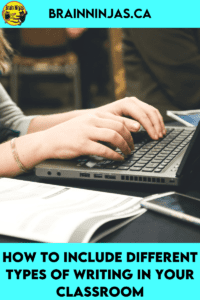
Students need to be taught the different formats.
Expository
If the writing is a list or directions, bullet points, numbers or transition words need to be included to help the reader keep track.
If the writing is prose or paragraphs, each paragraph should start with a main or topic sentence, followed by sentences that contain supporting details. The paragraph should wrap up with a concluding sentence. If the prose contains several paragraphs, the first paragraph should be an introductory paragraph explaining the main idea of each paragraph. It also needs a concluding paragraph that reviews the main ideas that were included in the paragraphs.
Narrative
Good narrative writing needs to include a beginning (where the problem is introduced), middle (all the steps to try to solve the problem) and an ending (how the problem is solved). To improve the writing beyond the basics, students should try to make an interesting beginning that starts in the middle of the action.
Narrative writing comes in many different genres. Students can write mysteries, science fiction or even dramas. Each genre has its own rules.
Persuasive
To be persuasive, the author needs to choose a side, position or point. They need to use facts to support why this position is best. We usually start persuasive writing in a letter format, but students can also learn to write in paragraphs. The topic sentence should declare the position. The following sentences should support the position. A concluding sentence should restate the position and give one more convincing push. We encourage our students to use words like convince, implore, influence, or persuade in their writing.
Remove the Barriers
Some students struggle with the physical act of writing. They have lots of ideas and know what to say, but they just can’t get the words out of their heads fast enough. We allow some students to record their thoughts. They replay their recording until they are able to write (or type) it all out. When we have time, we will scribe for students. We’ve used software like Google Read and Write to help students with word prediction or speech-to-text typing.
Some students struggle with what to write about. We find writing prompts help somewhat, but other students need help with writing out a brief outline. We practice this as a class so that the writing of the outline doesn’t become the entire writing project. Use a small sticky note, because it limits how much they can write.
Students that struggle with spelling and conventions will need help in the revision or editing phase. We allow students to use invented spelling during their rough drafts and explain that the words need to make sense. This might mean they need to have someone else read what they have written to see if it’s coherent.
If the physical act of writing is a barrier for students, alleviate some of the writing in other subject areas. We found that helping with writing other subject areas meant students had more energy to spend when doing writing for the purpose of writing. Students can work at building up writing stamina as they go (and that applies to everyone we’ve ever met).
Write Beyond the Story
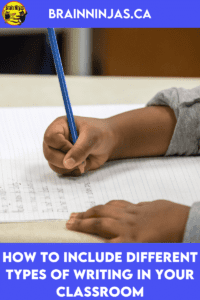
Don’t limit writing to the written form or a story or essay. Recordings, videos, podcasts, performances and even drawings are all forms of writing and should be explored. We’ve even had students write blogs. One of our most successful attempts at this was a student who wrote an entire blog about different video games. This was a kid who didn’t enjoy writing at all and then spent most of a winter break writing his own blog. Talk about an authentic reason to write.
Revise and Edit
Use all the little bits of writing to practice learning to revise and edit and then put it into practice for the works that are going to be published.
Show students that revising is messy. In fact, if you’ve written on one side of the pages, give your students a pair of scissors, a large piece of chart paper and some tape. Ask them to rewrite their work by adding to it or rearranging sentences. Even if the writing doesn’t turn out wonderfully, the process of revising is to make the mechanics of the story, argument or instructions make sense.
We save editing for our own work only after we’ve practiced editing sample work. Don’t use current work samples from your classroom to avoid embarrassing students. Instead, write up a few sentences along with the mistakes students keep making. Make the text big enough that students can write in any edits.
Some schools use specific editing marks. We’ve found that making students learn all the different symbols took longer than just fixing them in the first place so we tend to just write in or circle errors when editing with our students.
Assess One Thing At a Time-Until You Don’t
You can assess plenty of writing while it’s still in a rough draft form. Daily writes or quick writes can be a great way to assess certain aspects of writing. For example, if you need to assess whether or not students can properly use quotation marks, ask them to write a short paragraph that includes some dialogue. Explain that you’ll be looking to see if they can use the quotation marks and other punctuation correctly. Students will know what you are assessing.
Use these small assessments to help guide your lessons. Teach and practice the elements your students need the most help with.
Publish the Great Work
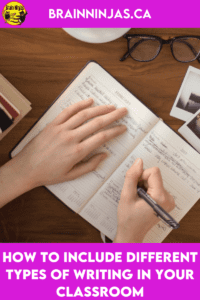
There is nothing that will kill creativity faster than being forced to copy and rewrite out all your writing. Don’t make students write rough drafts and good copies without a purpose and only do it for the works that need to be published for viewing.
Have students choose a piece they’ve been working on to complete the writing process. Work through this process together until students are ready to present their writing. Give them a more authentic reason to publish their work than “I need to mark it.”
We publish mini-books or anthologies of our writing that get shared in the library. Other classes read our work. Our students have made digital books where they included typed pages or scanned their written pages into a digital book. We published these by printing them at the end of the school year as gifts for our students. They loved them.
Submit your students’ writing for journals, writing contests or literary journals (for children). Getting a piece of work published elsewhere can be a huge motivator to keep writing.
Are you looking for other Language Arts ideas?
- Give Your Reading Instruction an Easy Twist
- How to Teach Reading With Book Clubs
- How to Use Google Meet to Run a Book Club
- Research Skills: How to Teach Text Features
- How to Celebrate Poem in Your Pocket Day
- Practical Strategies for Reluctant Readers
- Help! I Don’t Know How to Do Guided Reading
- Help! What Do the Other Kids Do During Guided Reading?
- Preparing For Guided Reading Groups
- How to Run Your Guided Reading Instruction
- Add Great Content to Your Literacy Lessons
- How to Set Up Your Reading Comprehension Schedule
- 22 Amazing Ways to Use Word Wall Words
What other types of writing do you include in your clasroom?
What other ways and types of writing do you include in your classroom? We’d love to hear all about it. Please share a comment below.

